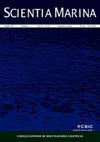Modelling the spatial population structure and distribution of the queen conch, Aliger gigas, on the Pedro Bank, Jamaica
IF 0.9
4区 生物学
Q4 MARINE & FRESHWATER BIOLOGY
引用次数: 0
Abstract
The estimation of reliable indices of abundance for sedentary stocks requires the incorporation of the underlying spatial population structure, including issues arising from the sampling design and zero inflation. We applied seven spatial interpolation techniques [ordinary kriging (OK), kriging with external drift (KED), a negative binomial generalized additive model (NBGAM), NBGAM plus OK (NBGAM+OK), a general additive mixed model (GAMM), GAMM plus OK (GAMM+OK) and a zero-inflated negative binomial model (ZINB) ] to three survey datasets to estimate biomass for the gastropod Aliger gigas on the Pedro Bank Jamaica. The models were evaluated using 10-fold cross-validation diagnostics criteria for choosing the best model. We also compared the best model estimations against two common design methods to assess the consequences of ignoring the spatial structure of the species distribution. GAMM and ZINB were overall the best models but were strongly affected by the sampling design, sample size, the coefficient of variation of the sample and the quality of the available covariates used to model the distribution (geographic location, depth and habitat). More reliable abundance indices can help to improve stock assessments and the development of spatial management using an ecosystem approach.模拟皇后海螺的空间种群结构和分布,在佩德罗银行,牙买加
对静止种群的可靠丰度指数的估计需要结合潜在的空间种群结构,包括抽样设计和零通货膨胀引起的问题。我们将7种空间插值技术[普通克里格(OK)、克里格外漂移(KED)、负二项广义可加模型(NBGAM)、NBGAM+OK (NBGAM+OK)、一般可加混合模型(GAMM)、GAMM+OK (GAMM+OK)和零膨胀负二项模型(ZINB)]应用于三个调查数据集,以估计牙买加佩罗银行腹足类Aliger gigas的生物量。采用10倍交叉验证诊断标准对模型进行评估,以选择最佳模型。我们还比较了两种常见设计方法的最佳模型估计,以评估忽略物种分布空间结构的后果。总体而言,GAMM和ZINB是最好的模型,但受到抽样设计、样本量、样本变异系数和用于模拟分布(地理位置、深度和栖息地)的可用协变量质量的强烈影响。更可靠的丰度指数有助于利用生态系统方法改进种群评估和发展空间管理。
本文章由计算机程序翻译,如有差异,请以英文原文为准。
求助全文
约1分钟内获得全文
求助全文
来源期刊

Scientia Marina
生物-海洋与淡水生物学
CiteScore
2.10
自引率
0.00%
发文量
21
审稿时长
6-12 weeks
期刊介绍:
Scientia Marina is the successor to Investigación Pesquera, a journal of marine sciences published since 1955 by the Institut de Ciències del Mar de Barcelona (CSIC). Scientia Marina is included in the Science Citation Index since 1998 and publishes original papers, reviews and comments concerning research in the following fields: Marine Biology and Ecology, Fisheries and Fisheries Ecology, Systematics, Faunistics and Marine Biogeography, Physical Oceanography, Chemical Oceanography, and Marine Geology. Emphasis is placed on articles of an interdisciplinary nature and of general interest.
 求助内容:
求助内容: 应助结果提醒方式:
应助结果提醒方式:


